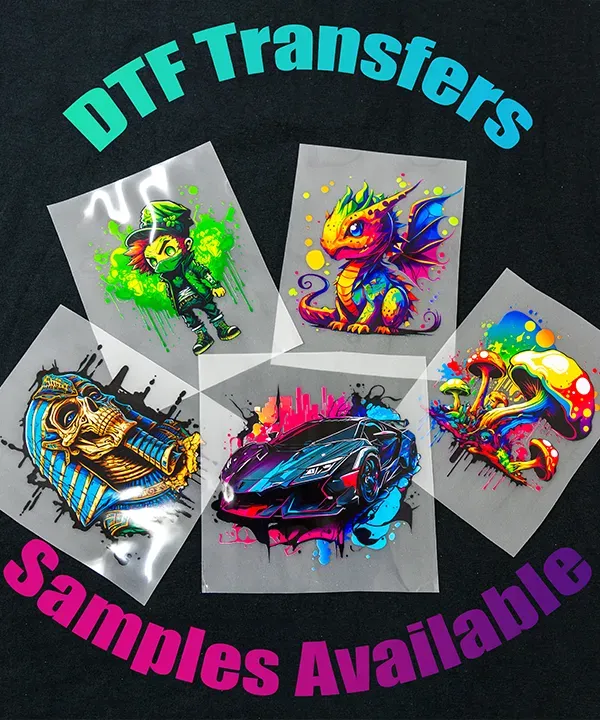DTF transfers are transforming the landscape of custom apparel, offering decorators an innovative means to bring their designs to life. Short for Direct to Film, these transfers allow for high-resolution prints that provide vivid colors and intricate details, making them ideal for any apparel printing project. Selecting DTF transfers not only involves choosing the right size to complement your design but also understanding the various apparel printing methods currently trending in the market. As we delve deeper into the world of DTF printing trends, this guide will equip you with the essential knowledge to create stunning and durable custom garments. Whether you’re outfitting a team or launching your own apparel line, mastering the art of selecting DTF transfers can elevate your brand’s presence and appeal.
Known as Direct to Film transfers, DTF transfers represent a modern approach to applying designs onto fabrics, using a specialized film that captures your graphics with impressive clarity. This unique method stands out among various apparel printing techniques due to its versatility, durability, and the vibrant finishes it achieves. By adopting DTF technology, you can cater to transforming your concepts into fashionable pieces that resonate with consumers’ desires. As you explore potential options for customization, focusing on the correct DTF transfer size becomes essential for creating unique garments that fit perfectly. This guide will help you navigate the intricacies of DTF methods and provide valuable insights into making informed decisions for your custom apparel ventures.
The Growing Popularity of DTF Transfers in Custom Apparel
DTF transfers have carved out a niche in the custom apparel industry, garnering attention for their impressive quality and versatility. Unlike traditional printing methods, DTF transfers allow for the application of intricate designs on various fabric types, making them increasingly popular among apparel decorators. The rise of this technology can be attributed to its ability to produce vibrant imagery that withstands the test of time and wear, making them a preferred choice for both large-scale orders and personalized pieces.
As brands increasingly focus on customization, the demand for flexible printing solutions like DTF continues to grow. Apparel companies are tapping into this trend, utilizing DTF transfers to create eye-catching and durable designs. The ability to print directly onto film and transfer these images onto fabrics has revolutionized the design process, allowing for high levels of detail that satisfy customers’ desires for unique and personalized garments.
Frequently Asked Questions
What are DTF transfers and how are they used in custom apparel?
DTF transfers, or Direct to Film transfers, are a printing method that allows detailed designs to be applied directly onto fabric. This technique involves printing on a special film and heat-pressing it onto garments, making it a favored choice for custom apparel due to its vibrant colors, durability, and versatility.
How do I choose the right size DTF transfers for my custom apparel?
Choosing the right size for DTF transfers is key to achieving an aesthetically pleasing design on custom apparel. For example, standard adult T-shirts typically accommodate designs ranging from 12 to 14 inches wide. Always consider the type of garment and its specific printing area when selecting your transfer size.
What factors should I consider in DTF transfer size when designing for kids’ apparel?
When designing DTF transfers for kids’ apparel, size down your designs for better fit. Children’s clothing requires simpler and smaller designs that do not overwhelm the garment. Tailor your DTF transfer sizes to fit within the unique dimensions of children’s clothing to enhance visual appeal.
Are there specific apparel printing methods tailored for DTF transfers?
DTF transfers are a unique apparel printing method designed to provide high-quality prints on various fabrics. Unlike traditional methods such as screen printing or DTG, DTF allows for precise detail, vibrant colors, and durability, making it ideal for custom garments.
What are the latest trends in DTF transfers for custom apparel?
Current DTF printing trends include a focus on sustainability, with more brands using eco-friendly materials. Additionally, the expansion of e-commerce and personalized apparel markets is driving innovation in DTF techniques, offering enhanced quality and results for custom apparel.
How does the fabric type affect DTF transfer application?
The type of fabric significantly influences how DTF transfers adhere and appear. Cotton is ideal due to natural fibers that enhance adhesion and vibrancy. Polyester may require specific temperatures for application, while blended fabrics may have unique challenges that should be addressed for durability after multiple washes.
| Element | Key Points |
|---|---|
| Understanding DTF Transfers | DTF transfers print designs directly onto fabric using a special film, ensuring vibrant colors and durability. |
| Choosing the Right Size | Consider design size (12-14 inches for adult tees), garment type, and available printing area for optimal fit. |
| Design Size | Different items (t-shirts, hoodies, kids’ apparel) require varying design sizes for aesthetic appeal. |
| Printing Area | Measure garment’s printing area to avoid overpowering the design and ensure good placement. |
| Fit Types | Size differences between kids and adults; simpler designs for kids are more effective. |
| Customization | Use size charts/templates for tailored designs that suit your targeted audience. |
| Material Considerations | Fabric type affects DTF transfer adherence; cotton, polyester, and blends have specific requirements. |
| Software Tools | Tools like Adobe Illustrator help visualize transfer designs before printing. |
| Current Trends | Sustainability and market expansion are vital trends shaping the DTF transfer industry. |
Summary
DTF transfers are essential for achieving high-quality custom apparel, emphasizing the importance of size selection. By understanding the nuances of garment dimensions, design intricacies, and material compatibilities, you can ensure your custom creations stand out. With an increasing focus on sustainability and evolving market trends, staying informed about DTF transfers will not only enhance the visual appeal of your products but also resonate with environmentally conscious consumers. As the custom apparel industry continues to grow, mastering DTF transfers will set you on a path toward success.

